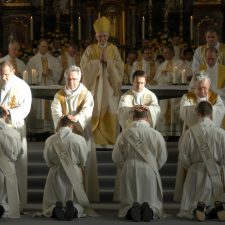 When told of the Society of Saint John’s abuses, Timlin defended the accused priests, writing in a 2002 letter to the Vatican that they had “stopped the practice of ‘sleeping with boys’ as soon as I explained how imprudent this was.”
When told of the Society of Saint John’s abuses, Timlin defended the accused priests, writing in a 2002 letter to the Vatican that they had “stopped the practice of ‘sleeping with boys’ as soon as I explained how imprudent this was.”
(Corky Siemaszko – NBC News) On Dec. 18, 2001, a desperate North Carolina dad wrote a letter to the Vatican asking the leaders of the Roman Catholic Church to discipline a group of priests at a Pennsylvania boys’ boarding school who he said took turns sexually abusing his teenage son.
The priests were members of an organization called the Society of Saint John, the father wrote, and Bishop James Timlin, then the head of the Diocese of Scranton, had allowed them to take up residence at St. Gregory’s Academy in Elmhurst, Pennsylvania.
“How long will the Bishop of Scranton tolerate this Society of Priests and promote them and their plans?” the father, whose name NBC News is not disclosing to protect his son’s identity, asked in the 2001 letter.
The answer turned out to be two more years. It was not until 2003, after the man’s son filed a federal lawsuit, that the Society of Saint John was finally disbanded in Scranton. The lawsuit accused two of the society’s priests of cultivating “intimate relationships with students” and of plying students “with alcohol, as well as sleeping with them.”
The society was singled out in the scathing grand jury report that Pennsylvania Attorney General Josh Shapiro released in August, which included its leader and three members, along with 297 other Pennsylvania clerics that he branded “predator priests.”
The society is a particularly chilling example of priests with red flags in their backgrounds who were allowed to operate in close proximity to the most vulnerable church members with little oversight. Clerical sex abuse survivors say the society’s story is a rebuke of Timlin, who is now retired and was accused in the grand jury report of failing to act quickly to remove dozens of priests accused of abuse during his 20-year tenure as the head of the Diocese of Scranton.
Research: